Page 587 of 648
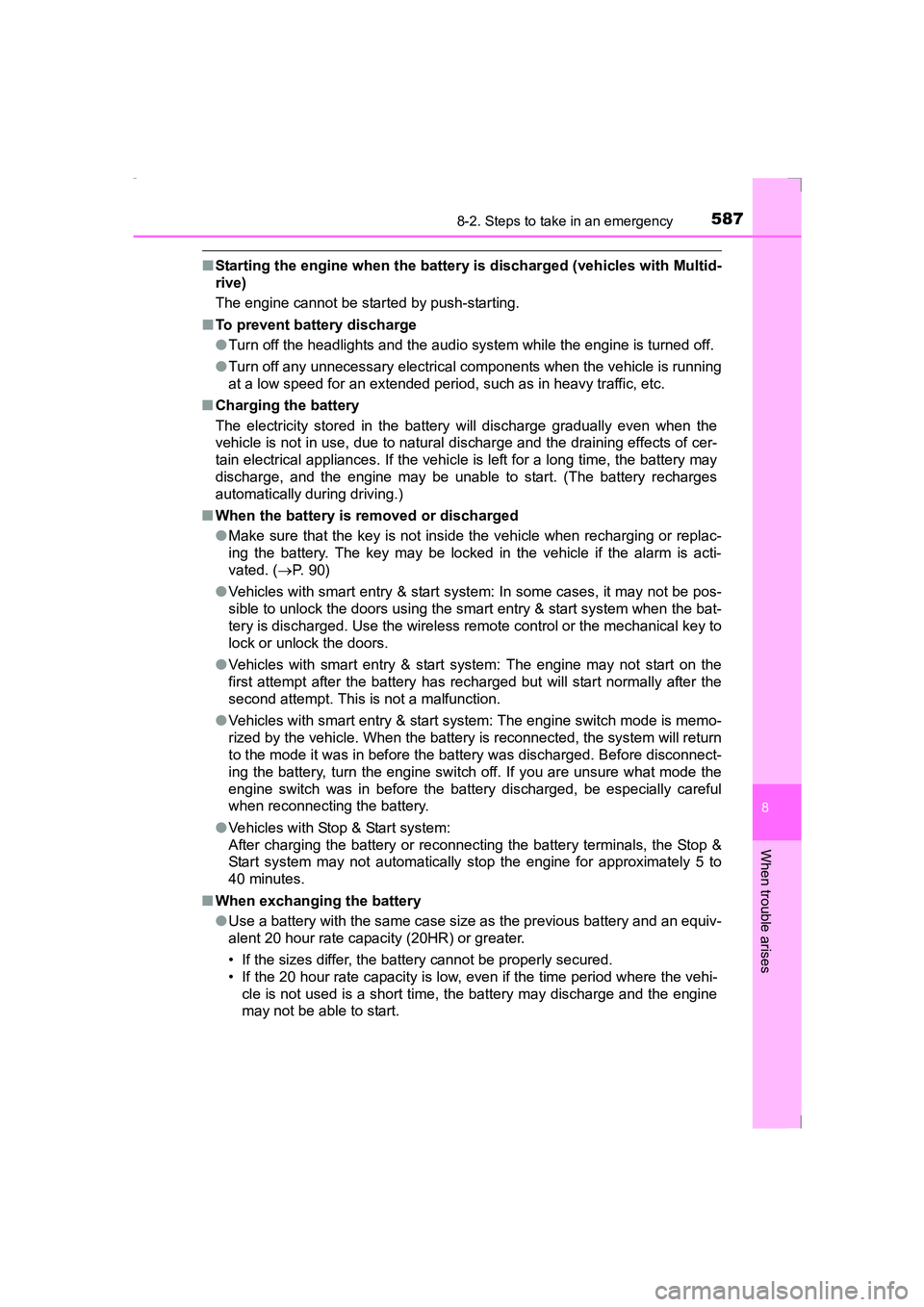
5878-2. Steps to take in an emergency
AVENSIS_OM_OM20C20E_(EE)
8
When trouble arises
■Starting the engine when the battery is discharged (vehicles with Multid-
rive)
The engine cannot be started by push-starting.
■ To prevent battery discharge
●Turn off the headlights and the audio system while the engine is turned off.
● Turn off any unnecessary electrical components when the vehicle is running
at a low speed for an extended period, such as in heavy traffic, etc.
■ Charging the battery
The electricity stored in the battery will discharge gradually even when the
vehicle is not in use, due to natural discharge and the draining effects of cer-
tain electrical appliances. If the vehicle is left for a long time, the battery may
discharge, and the engine may be unable to start. (The battery recharges
automatically during driving.)
■ When the battery is removed or discharged
●Make sure that the key is not inside the vehicle when recharging or replac-
ing the battery. The key may be locked in the vehicle if the alarm is acti-
vated. ( →P. 90)
● Vehicles with smart entry & start system: In some cases, it may not be pos-
sible to unlock the doors using the smart entry & start system when the bat-
tery is discharged. Use the wireless remote control or the mechanical key to
lock or unlock the doors.
● Vehicles with smart entry & start system: The engine may not start on the
first attempt after the battery has recharged but will start normally after the
second attempt. This is not a malfunction.
● Vehicles with smart entry & start system: The engine switch mode is memo-
rized by the vehicle. When the battery is reconnected, the system will return
to the mode it was in before the battery was discharged. Before disconnect-
ing the battery, turn the engine switch off. If you are unsure what mode the
engine switch was in before the battery discharged, be especially careful
when reconnecting the battery.
● Vehicles with Stop & Start system:
After charging the battery or reconnecting the battery terminals, the Stop &
Start system may not automatically stop the engine for approximately 5 to
40 minutes.
■ When exchanging the battery
●Use a battery with the same case size as the previous battery and an equiv-
alent 20 hour rate capacity (20HR) or greater.
• If the sizes differ, the battery cannot be properly secured.
• If the 20 hour rate capacity is low, even if the time period where the vehi-
cle is not used is a short time, the battery may discharge and the engine
may not be able to start.
AVENSIS_OM_OM20C20E_(EE).book Page 587 Thursday, January 29, 2015 1:47 PM
Page 599 of 648
5999-1. Specifications
AVENSIS_OM_OM20C20E_(EE)
9
Vehicle specifications
■Engine number
The engine number is stamped on the engine block as shown.
�XGasoline engine
�XGasoline engine�XDiesel engine
Engine
Model 1ZR-FAE, 2ZR-FAE, 3ZR-FAE
Type 4-cylinder in line, 4-cycle, gasoline
Bore and stroke
�X1ZR-FAE engine
80.5 × 78.5 mm (3.17 × 3.09 in.)
�X2ZR-FAE engine
80.5 × 88.3 mm (3.17 × 3.48 in.)
�X3ZR-FAE engine
80.5 × 97.6 mm (3.17 × 3.84 in.)
Displacement
�X1ZR-FAE engine
1598 cm
3 (97.5 cu.in.)
�X2ZR-FAE engine
1798 cm
3 (109.7 cu.in.)
�X3ZR-FAE engine
1987 cm
3 (121.3 cu.in.)
Valve clearance
(engine cold) Automatic adjustment
AVENSIS_OM_OM20C20E_(EE).book Page 599 Thursday, January 29,
2015 1:47 PM
Page 610 of 648
6109-1. Specifications
AVENSIS_OM_OM20C20E_(EE)
The fluid capacity is the quantity of reference. If replacement is neces-
sary, contact any authorized Toyota dealer or repairer, or another duly
qualified and equipped professional.
Electrical system
Battery
Open voltage at 20°C (68 °F): 12.6 12.8 V Fully charged
12.2 12.4 V Half charged
11 . 8 12.0 V Discharged
(Voltage is checked 20 minutes after
the engine and all the lights are
turned off.)
Charging rates 5 A max.
Multidrive
Fluid capacity
(reference)2ZR-FAE engine7.5 L (7.9 qt., 6.6 Imp.qt.)
3ZR-FAE engine7.2 L (7.6 qt., 6.3 Imp.qt.)
Fluid typeToyota Genuine CVT Fluid FE
NOTICE
■ Multidrive fluid type
Using transmission fluid other than “Toyota Genuine CVT Fluid FE” may
cause deterioration in shift quality, locking up of your transmission accom-
panied by vibration, and ultimately dam age the transmission of your vehicle.
sec_09-01.fm Page 610 Friday, February 20, 2015 3:48 PM
Page 625 of 648
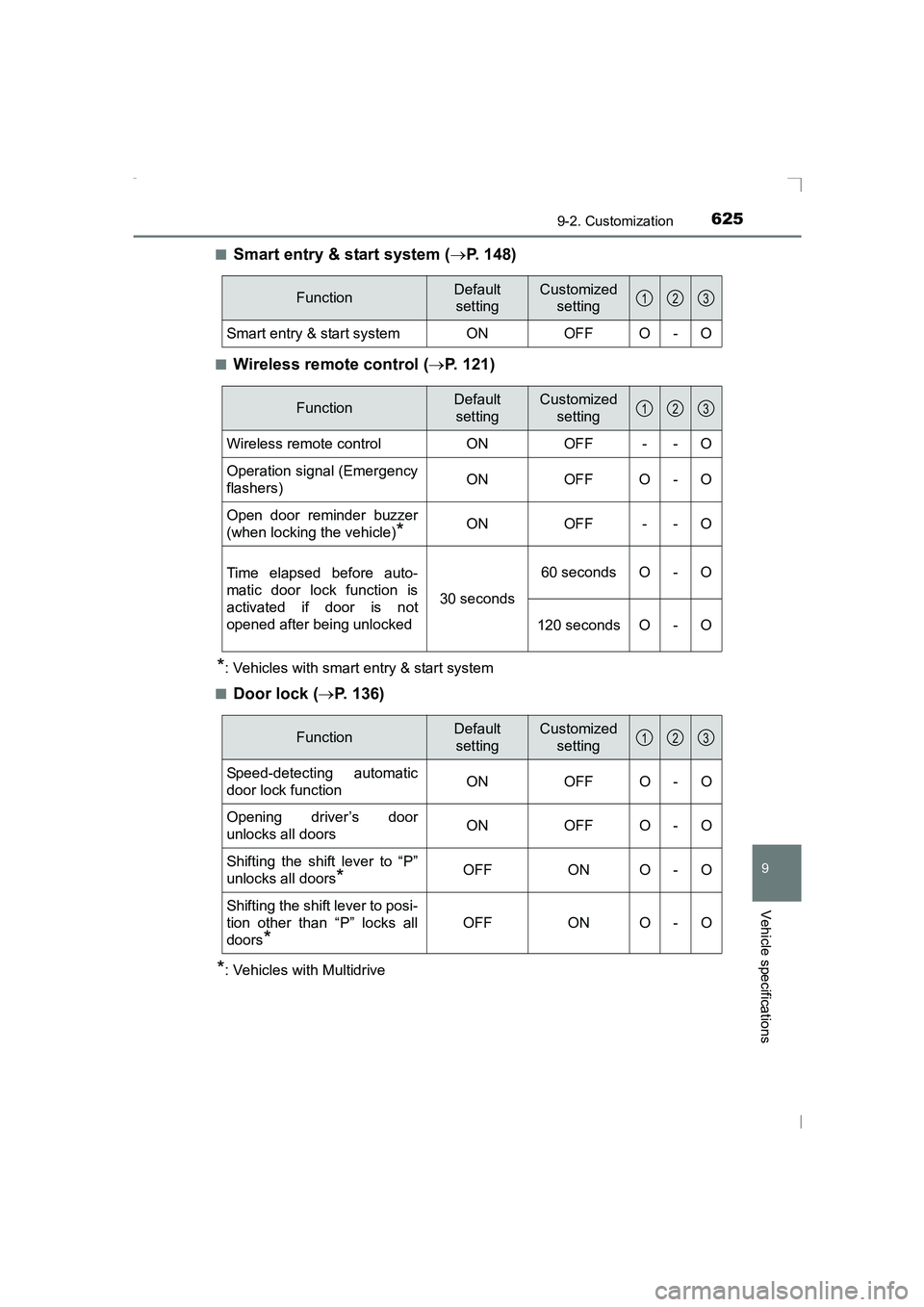
6259-2. Customization
AVENSIS_OM_OM20C20E_(EE)
9
Vehicle specifications
■Smart entry & start system (→P. 148)
■Wireless remote control ( →P. 121)
*: Vehicles with smart entry & start system
■
Door lock ( →P. 136)
*: Vehicles with Multidrive
FunctionDefault
settingCustomized setting
Smart entry & start system ON OFF O - O
123
FunctionDefault
settingCustomized setting
Wireless remote control ON OFF - - O
Operation signal (Emergency
flashers) ON OFF O - O
Open door reminder buzzer
(when locking the vehicle)
*ON OFF - - O
Time elapsed before auto-
matic door lock function is
activated if door is not
opened after being unlocked 30 seconds60 seconds O - O
120 seconds O - O
123
FunctionDefault settingCustomized setting
Speed-detecting automatic
door lock functionONOFFO-O
Opening driver’s door
unlocks all doorsONOFF O -O
Shifting the shift lever to “P”
unlocks all doors
*OFFONO-O
Shifting the shift lever to posi-
tion other than “P” locks all
doors
*
OFFONO-O
123
AVENSIS_OM_OM20C20E_(EE).book Page 625 Thursday, January 29, 2015 1:47 PM
Page 626 of 648
6269-2. Customization
AVENSIS_OM_OM20C20E_(EE)■
Automatic light control system (
→P. 232)
*: If equipped
■
Illumination ( →P. 399)
*: Vehicles with smart entry & start system
FunctionDefault
settingCustomized setting
Light sensor sensitivityLevel 3Level 1 to 5O-O
Follow me home*
(Time elapsed before head-
lights automatically turn off)30
seconds
60
seconds
--
O90
seconds
120
seconds
123
FunctionDefault settingCustomized setting
Time period before lights turn
off 15 seconds7.5 seconds
O-O
30 seconds
Operation after the engine
switch is turned to the
“LOCK” position (vehicles
without smart entry & start
system) or off (vehicles with
smart entry & start system)
ONOFF - - O
Operation when the doors
are unlocked ON OFF - - O
Operation when you
approach the vehicle with the
electronic key on your person
(When the interior light
switch is in the door posi-
tion)
*
ONOFF - - O
Foot lightsONOFF - - O
123
AVENSIS_OM_OM20C20E_(EE).book Page 626 Thursday, January 29,
2015 1:47 PM
Page 630 of 648
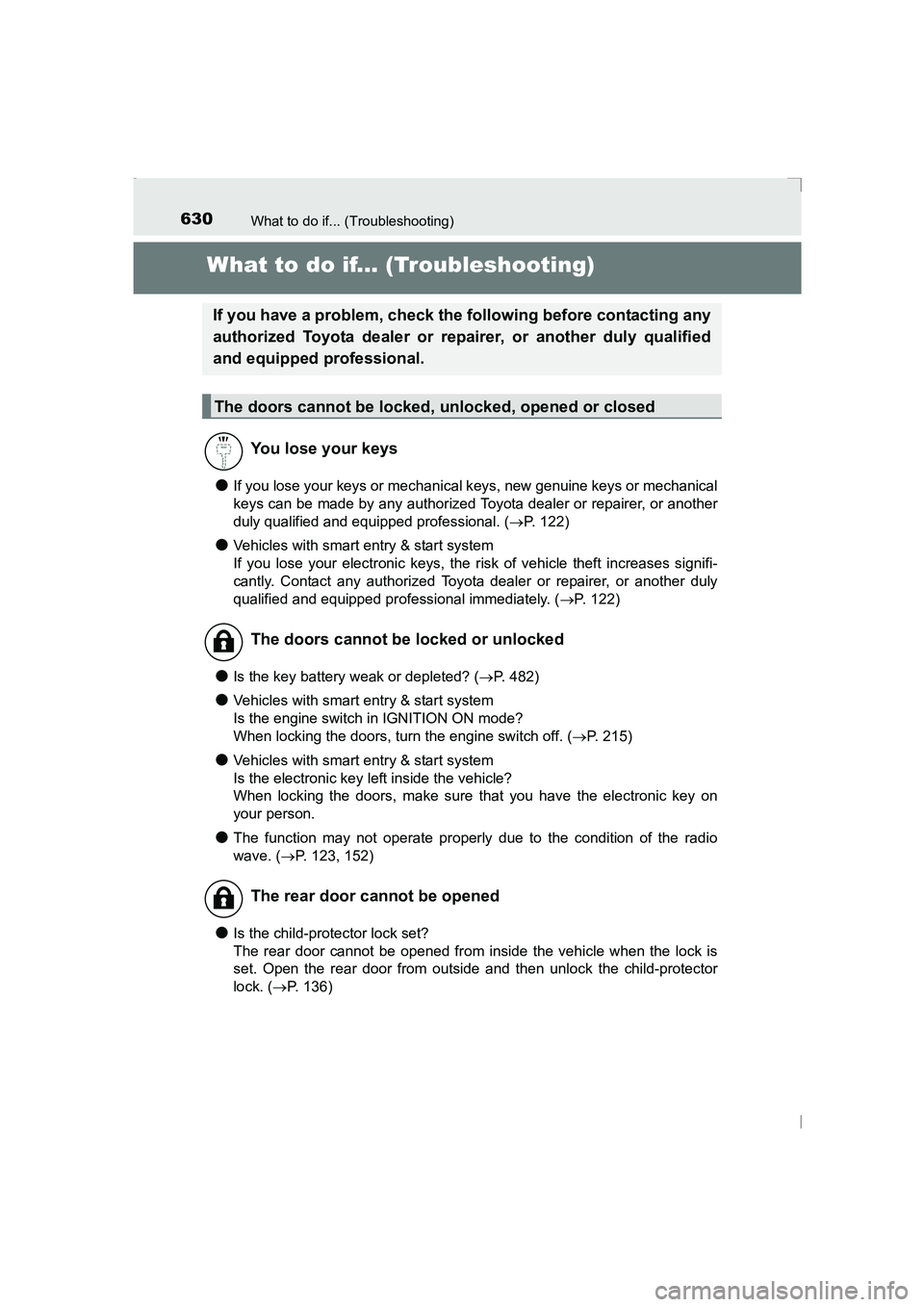
630What to do if... (Troubleshooting)
AVENSIS_OM_OM20C20E_(EE)
What to do if... (Troubleshooting)
●If you lose your keys or mechanical keys, new genuine keys or mechanical
keys can be made by any authorized Toyota dealer or repairer, or another
duly qualified and equipped professional. (→P. 122)
●Vehicles with smart entry & start system
If you lose your electronic keys, the risk of vehicle theft increases signifi-
cantly. Contact any authorized Toyota dealer or repairer, or another duly
qualified and equipped professional immediately. ( →P. 122)
●Is the key battery weak or depleted? ( →P. 482)
●Vehicles with smart entry & start system
Is the engine switch in IGNITION ON mode?
When locking the doors, turn the engine switch off. ( →P. 215)
●Vehicles with smart entry & start system
Is the electronic key left inside the vehicle?
When locking the doors, make sure that you have the electronic key on
your person.
●The function may not operate properly due to the condition of the radio
wave. ( →P. 123, 152)
●Is the child-protector lock set?
The rear door cannot be opened from inside the vehicle when the lock is
set. Open the rear door from outside and then unlock the child-protector
lock. ( →P. 136)
If you have a problem, check the following before contacting any
authorized Toyota dealer or repairer, or another duly qualified
and equipped professional.
The doors cannot be locked, unlocked, opened or closed
You lose your keys
The doors cannot be locked or unlocked
The rear door cannot be opened
AVENSIS_OM_OM20C20E_(EE).book Page 630 Thursday, January 29, 2015 1:47 PM
Page 631 of 648
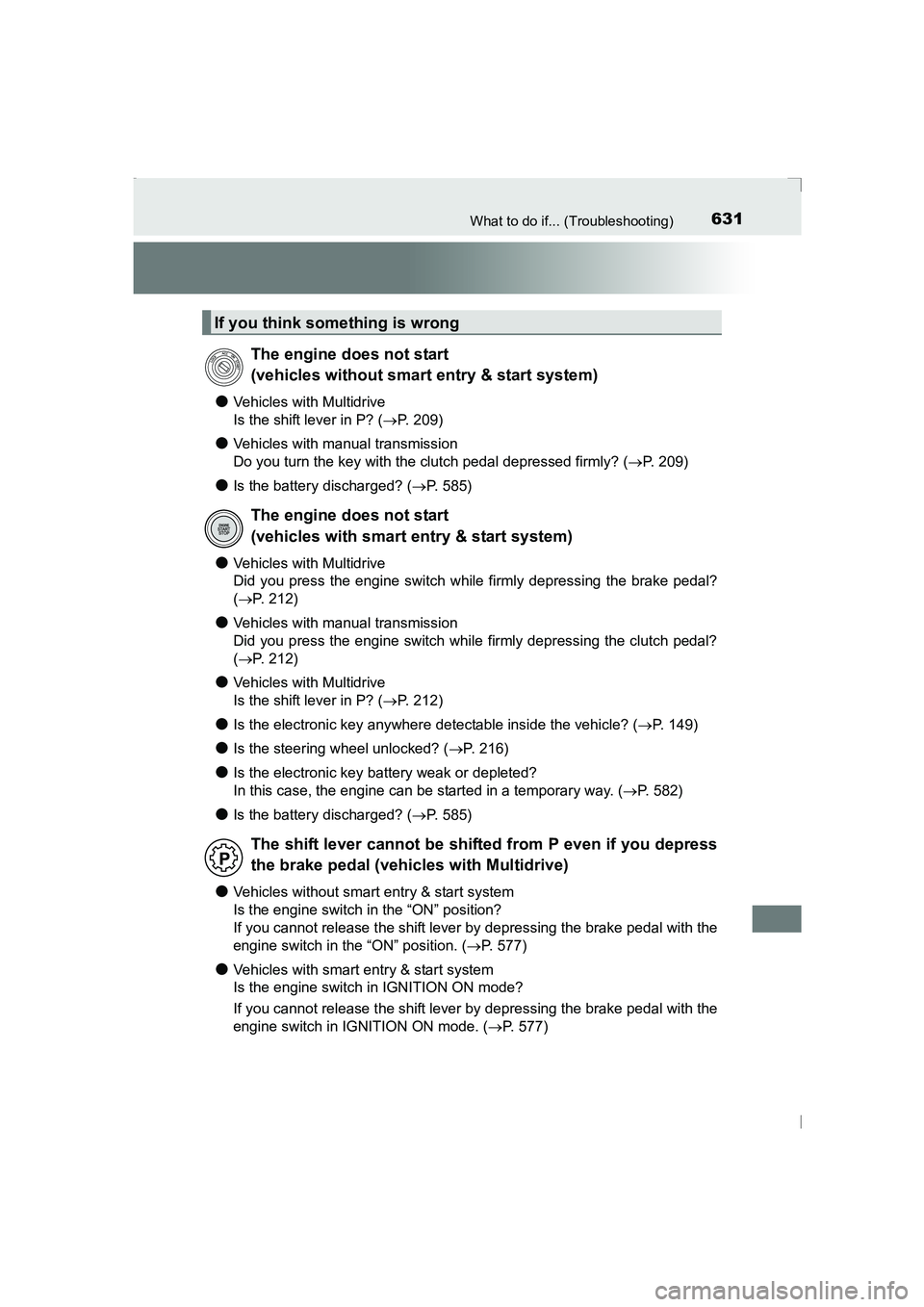
631What to do if... (Troubleshooting)
AVENSIS_OM_OM20C20E_(EE)
●Vehicles with Multidrive
Is the shift lever in P? (→P. 209)
●Vehicles with manual transmission
Do you turn the key with the clutch pedal depressed firmly? ( →P. 209)
●Is the battery discharged? ( →P. 585)
●Vehicles with Multidrive
Did you press the engine switch while firmly depressing the brake pedal?
(→ P. 212)
●Vehicles with manual transmission
Did you press the engine switch while firmly depressing the clutch pedal?
(→ P. 212)
●Vehicles with Multidrive
Is the shift lever in P? ( →P. 212)
●Is the electronic key anywhere detectable inside the vehicle? ( →P. 149)
●Is the steering wheel unlocked? ( →P. 216)
●Is the electronic key battery weak or depleted?
In this case, the engine can be started in a temporary way. ( →P. 582)
●Is the battery discharged? ( →P. 585)
●Vehicles without smart entry & start system
Is the engine switch in the “ON” position?
If you cannot release the shift lever by depressing the brake pedal with the
engine switch in the “ON” position. ( →P. 577)
●Vehicles with smart entry & start system
Is the engine switch in IGNITION ON mode?
If you cannot release the shift lever by depressing the brake pedal with the
engine switch in IGNITION ON mode. ( →P. 577)
If you think something is wrong
The engine does not start
(vehicles without smart entry & start system)
The engine does not start
(vehicles with smart entry & start system)
The shift lever cannot be shifted from P even if you depress
the brake pedal (vehicles with Multidrive)
AVENSIS_OM_OM20C20E_(EE).book Page 631 Thursday, January 29, 2015 1:47 PM
Page 632 of 648
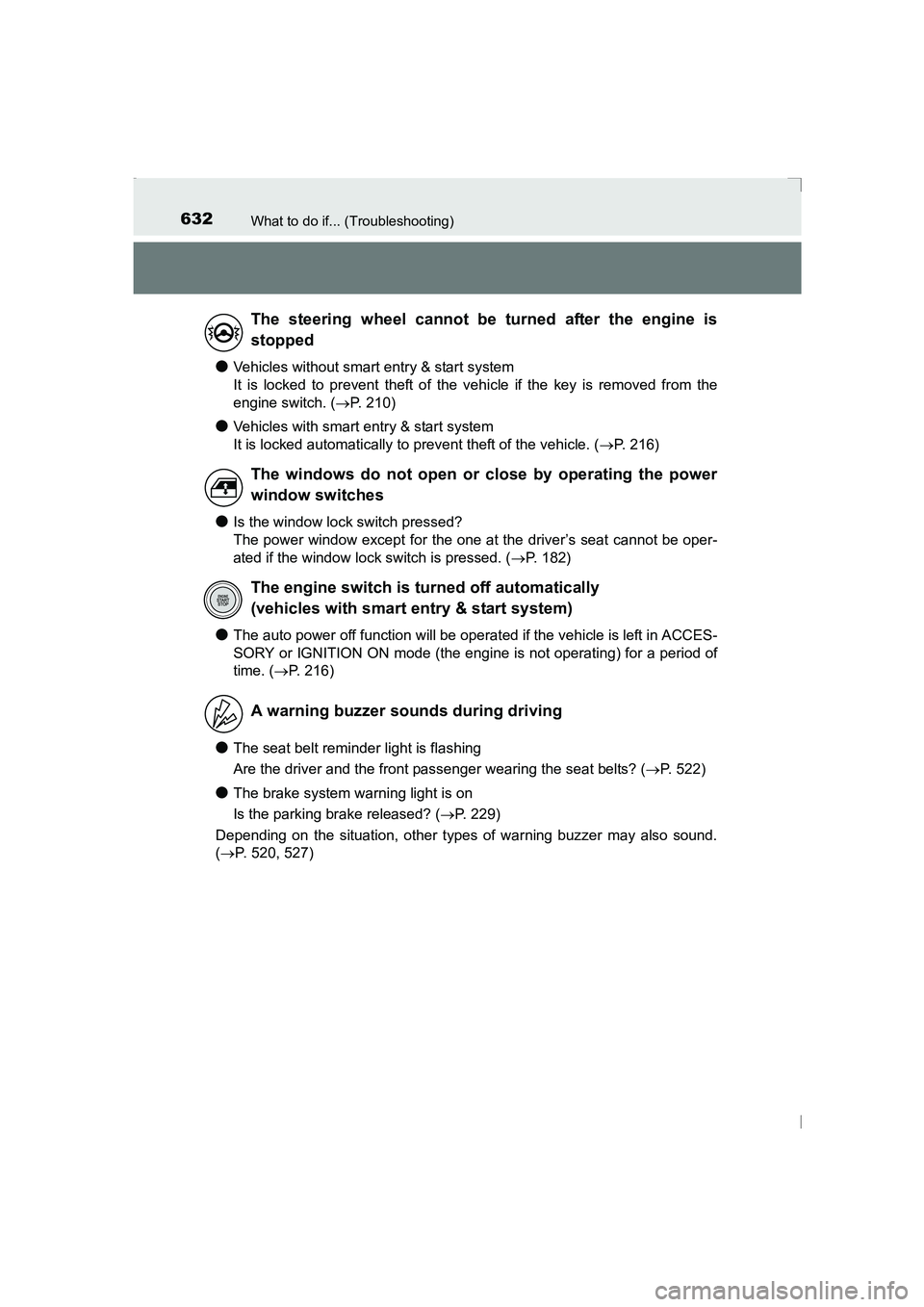
632What to do if... (Troubleshooting)
AVENSIS_OM_OM20C20E_(EE)
●Vehicles without smart entry & start system
It is locked to prevent theft of the vehicle if the key is removed from the
engine switch. (→P. 210)
●Vehicles with smart entry & start system
It is locked automatically to prevent theft of the vehicle. ( →P. 216)
●Is the window lock switch pressed?
The power window except for the one at the driver’s seat cannot be oper-
ated if the window lock switch is pressed. ( →P. 182)
●The auto power off function will be operated if the vehicle is left in ACCES-
SORY or IGNITION ON mode (the engine is not operating) for a period of
time. ( →P. 216)
●The seat belt reminder light is flashing
Are the driver and the front passenger wearing the seat belts? ( →P. 522)
●The brake system warning light is on
Is the parking brake released? ( →P. 229)
Depending on the situation, other types of warning buzzer may also sound.
( → P. 520, 527)
The steering wheel cannot be turned after the engine is
stopped
The windows do not open or close by operating the power
window switches
The engine switch is turned off automatically
(vehicles with smart entry & start system)
A warning buzzer sounds during driving
AVENSIS_OM_OM20C20E_(EE).book Page 632 Thursday, January 29, 2015 1:47 PM